Native North American Wildflowers
What's special about wildflowers?
Long before I trekked the paths of Mackinac Island, where daisies and other flowers grew in abundance, I was in love with wildflowers. My father, an avid outdoorsman, took us camping and I would observe the beauty of the fields and woods. I look forward to the changing of the seasons. Springtime brings the flowering trees and the winter’s ground opens to reveal crocuses and daffodils leading the way for summer. Here are a few of the wildflowers I love to see.
Photos of Daisies and Blackeyed Susans
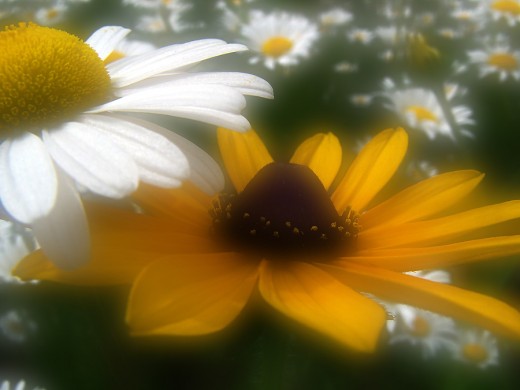
Yellow and White Wildflowers
Daisy: A white, Ox-Eye Daisy is the ‘flower’ for the month of April. I’ve been familiar with this flower since my pre-teen years, April being my birthday month. When my father would leave for outdoor excursions, I would follow along gathering fistfuls to place in the house when we returned.
A Daisy has the history of being the choice flower to determine if a heartthrob loves you: “He loves me, he loves me not” is the statement used as one plucks the petals that surround the bright yellow center.
Black-eyed Susan: The Black-eyed Susan is another field flower that grows abundantly during the summer months in North America along roadsides, in fields and meadows. Its shape is similar to the Daisy-a long green stem with small leaves along it, and bright yellow petals surrounding a chocolate brown center.
Maryland’s state flower since April 18, 1918, the Maryland Association of School Libraries sponsors a reading program to promote literacy called the Black-Eyed Susan Award. Each year students in all age groups register to vote for their favorite from a select group of books. They must read at least three of the nominated selections to enter their vote. The winning author receives an engraved pewter plate.
Meadows and gardens are brightened by colorful lilies
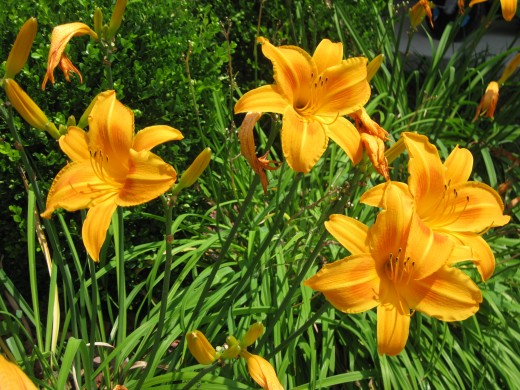
Variety of Lilies
There are many types of lilies that grow abundantly across the nation, along roadside or in swampy wooded areas. Tiger lilies can be discerned from other lilies because their leaves alternate along the stem. The Day lily is noticeably different from other lilies in that family on two counts: first, because it lacks the spots that are visible markings for other lilies, and second, because, true to its name, it lasts only one day.
The bright orange petals vary between curling backward, as seen in the Turk’s-Cap; hanging over like a bell, as seen in the Canada Lily; and the Michigan Lily whose petals appear to be a combination of the Canada Lily and the Turk’s Cap: a drooping head whose petals curl back.
Variety of lilies also come in yellow. Some of these include the Canada Lily, the Trout Lily and the Clintonia.
Photos of Sunflowers
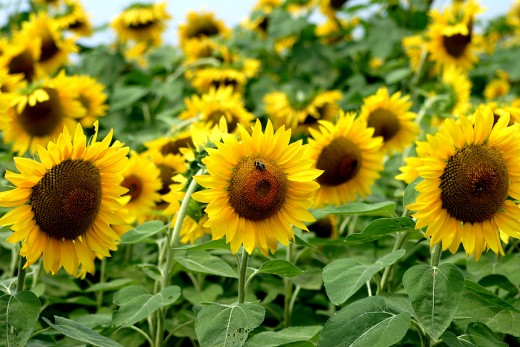
Prairie Wildflowers
Sunflowers can be commonly found throughout the Great Plains and is the state flower of Kansas. Native American’s used this plant for food and medicinal purposes, and through careful propagation and cultivation sunflower oil and seeds are consumed on a regular basis.
There is no mistaking the tall, graceful sunflower. It looms above other wildflowers on a coarse stem between 5 -12 feet tall. It’s ‘head’ is filled with tiny florets that mature into sunflower seeds, and the sterile florets surround the center with bright, yellow petals that follow the path of the sun.
The Sunflower has been revered by many ancient cultures, such as the Aztecs.
The Forget-Me-Not: A Delicate Blue Beauty
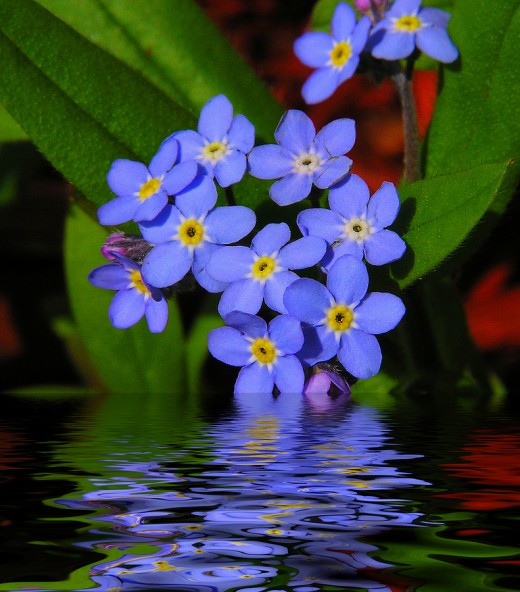
Blue Wildflower
The tiny Forget-me-not belongs to the largest state in the union: Alaska, as its state flower. The dainty, blue flower grows in clusters on its stem, a speck of yellow in the center. I first came across this delicate plant on Mackinac Island, a summer resort in Michigan, on Lake Huron. It grew abundantly throughout the island. I saw it in this abundance again, while living in our Northern most state. For anyone who has visited or lived in Alaska, you know how applicable a choice it is as a state flower. One doesn’t easily forget Alaska.
The genus name, Myosotis, is Greek for ‘mouse’s ear’, referencing the leaves. It has a strong folklore history. In one German legend it is said that when God was naming the plants, this tiny flower spoke up saying, “Forget me not, O, Lord” and God granted it that name. In a second religious themed legend, the Christ child was sitting on Mother Mary’s lap when he said he wished that future generations could see her eyes. He touched her eyes, then sweeping his hand across the ground, the blue flowers appeared. Ladies wear this flower as a symbol of faithfulness and lasting love. It is reminisce of a legend about a knight and his lady. As he picked a bouquet of these delicate flowers, he fell into the river, but threw the bouquet to her and shouted, “Forget-me-not” before being swept away. It used to be the symbol for the departed, until the poppy replaced it.
Colorful Poppies can be found across the country
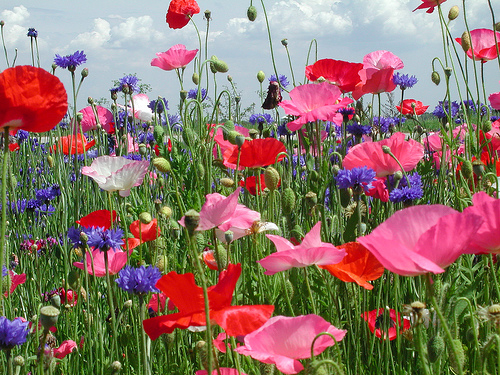
Meadow Wildflower: Poppies
Poppies grow in abundance in fields and can show up in any color. There relaxed, gentle swaying in the breeze is an easy fit for the laid back days of summer. The Poppy consists of four, broad petals on a thin stem, of which there are many varieties of. The California Poppy , a yellow-orange/gold colored version, is the state flower. During the spring season a blanket of poppies cover Antelope Valley California Poppy Reserve, and the state has an official poppy day that was established April 6, 1903; as well as a California Poppy Festival.
In North Carolina, colorful poppies can be seen bobbing their heads along highways, thanks to the 1987 Surface Transportation Urban Relocation Authorization Act which required beautifying federal highway landscapes.
Poppies have the reputation of being associated with sleep and death. In the movie, The Wizard of Oz, Dorothy and friends have a foiled attempt to cross the poppy field because of the sleepiness that the flowers induced. Opium Poppies can be used as a powerfully, addictive drug that promotes tranquility. The Veterans of Foreign Legions have used the red Poppy as a symbol of those that have lost their lives in war. It is now the official flower of ‘remembrance’.
The Lady Bird Johnson Wildflower Center
There are many wildflowers that we enjoy along roads, woods, wetlands, meadows, and in our backyards. But, at least 30% of the native plants of North America are endangered of becoming extinct. In Minnesota, the state flower, the Pink and White Lady’s Slipper, is on the endangered list. It is unlawful to pick or remove this plant from its natural habitat.
In 1982, Lady Bird Johnson co-founded with actress Helen Hayes, the National Wildflower Research Center , (housed at the University of Texas, Austin), for the promotion and restoration of native plants. The center, now renamed the Lady Bird Johnson Wildflower Center , educates the public, teaches gardeners how to grow endangered species, and offers an online database network for native plant information.
Lady Bird Johnson Wildflower Center
Why should we protect the wildflowers?
Here are some important reasons why we must be guardians for wildflowers of our land:
1. Their beauty brightens our countryside and our homes.
2. They are an important addition to our water and soil conservation.
3. They are an important part of our ecosystem offering a habitat for birds and insects
4. They offer medicinal uses.
5. They offer food sources.
Please help to spread the word to ensure that future generations may enjoy the beauty that we do.
Visit the Lady Bird Johnson Wildflower Center in Austin, Texas. It will be open on Easter Sunday, (April 24, 2011) and Memorial Day, (Monday, May 30, 2011). There is a fee.
For photography enthusiasts the www.wildflower.org site is hosting a photo contest. Click: ‘About’ for further information. Contest entries are accepted through June 15, 2011.









